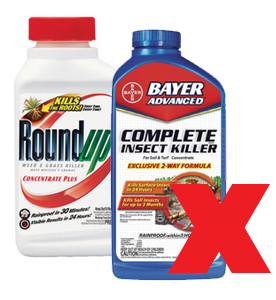Keep it growing!A well established pollinator garden requires little care, but a few essential gardening practices established early on can keep your garden growing season after season.
Watering Although well-established native perennials require little water because of their deep roots, it is important to make sure new plantings are well watered in their first season. Apply water gradually to allow water to soak in and not run off. |
About the Projectgetting startedplant selectionReady, set, plant!:: TIPS & maintenanceCertify your gardenneighborhood contacts |
Be sure to water regularly through the dry summer months. New plantings and annuals, in particular, need to be monitored regularly during long dry periods. Once fall comes, you can relax a little, but not too much, as plants need adequate water to carry them through the winter. If you get a good soaking rain, of course, you can adjust your watering schedule. Watering can be tedious, but it also can be a time to relax and reflect on the beauty of your planting area.
Weeding
Weeds will steal precious nutrients, sunshine and water away from your perennials if they are not diligently removed. Weeds should be monitored regularly so that the weeds don’t have a chance to go to seed and turn a small nuisance into a big problem.
Eliminate any invasive plants encroaching on your area, such as crown vetch, garlic mustard, and Bradford Pear. If you are unfamiliar with the invasive species, Master Gardeners can help you identify them.
Worried about weeds? As your pollinator garden becomes well established, it will do much of the work for you by crowding out many nuisance weeds, requiring only light cultivation.
Weeds will steal precious nutrients, sunshine and water away from your perennials if they are not diligently removed. Weeds should be monitored regularly so that the weeds don’t have a chance to go to seed and turn a small nuisance into a big problem.
Eliminate any invasive plants encroaching on your area, such as crown vetch, garlic mustard, and Bradford Pear. If you are unfamiliar with the invasive species, Master Gardeners can help you identify them.
Worried about weeds? As your pollinator garden becomes well established, it will do much of the work for you by crowding out many nuisance weeds, requiring only light cultivation.
|
Pesticides and Herbicides
Do not use pesticides in or near the habitat. Insecticides kill beneficial insects as well as those considered a nuisance. Certain classes of insecticides known as neonicotinoids have been linked to Colony Collapse Disorder. Herbicides are damaging to butterflies because they may eliminate sources of food for caterpillars. |
Matters of Mulch
As gardeners, we have been trained to see a thick layer of mulch as a sign of a tidy well kept garden. The reality however is that many wood mulches sold today contain wood waste materials, and are often contaminated with dyes, chemicals, and other hazardous materials. These materials will inhibit or may cause harm to plant growth. Also, many native bee species are ground nesting, meaning they need access to bare earth to make their home and lay their eggs.
If mulch you must, we recommend using compost instead. A thick layer of finished compost will inhibit weeds, while also benefiting soil by returning nutrients as it breaks down. Another thought - Mulch only the front of garden beds, or only areas that are visible, leaving the rest bare.
As gardeners, we have been trained to see a thick layer of mulch as a sign of a tidy well kept garden. The reality however is that many wood mulches sold today contain wood waste materials, and are often contaminated with dyes, chemicals, and other hazardous materials. These materials will inhibit or may cause harm to plant growth. Also, many native bee species are ground nesting, meaning they need access to bare earth to make their home and lay their eggs.
If mulch you must, we recommend using compost instead. A thick layer of finished compost will inhibit weeds, while also benefiting soil by returning nutrients as it breaks down. Another thought - Mulch only the front of garden beds, or only areas that are visible, leaving the rest bare.
Leave "fall cleanup" until spring
Though it may be tempting to tidy up your garden at the end of the season, many pollinators make their homes and overwinter in the spent blooms and dried stalks of your pollinator garden. Leave fall cleanup until spring, when temperatures have risen to a point where bees and butterflies have had a chance to emerge. When’s the right time to cut back the previous season’s growth? As a rule, when the plant begins producing new growth, it is safe to cut back or remove dead plant material.
Where space and conditions allow, consider leaving a small pile of logs or dead branches as habitat for cavity nesting bees and other wildlife.
Though it may be tempting to tidy up your garden at the end of the season, many pollinators make their homes and overwinter in the spent blooms and dried stalks of your pollinator garden. Leave fall cleanup until spring, when temperatures have risen to a point where bees and butterflies have had a chance to emerge. When’s the right time to cut back the previous season’s growth? As a rule, when the plant begins producing new growth, it is safe to cut back or remove dead plant material.
Where space and conditions allow, consider leaving a small pile of logs or dead branches as habitat for cavity nesting bees and other wildlife.



